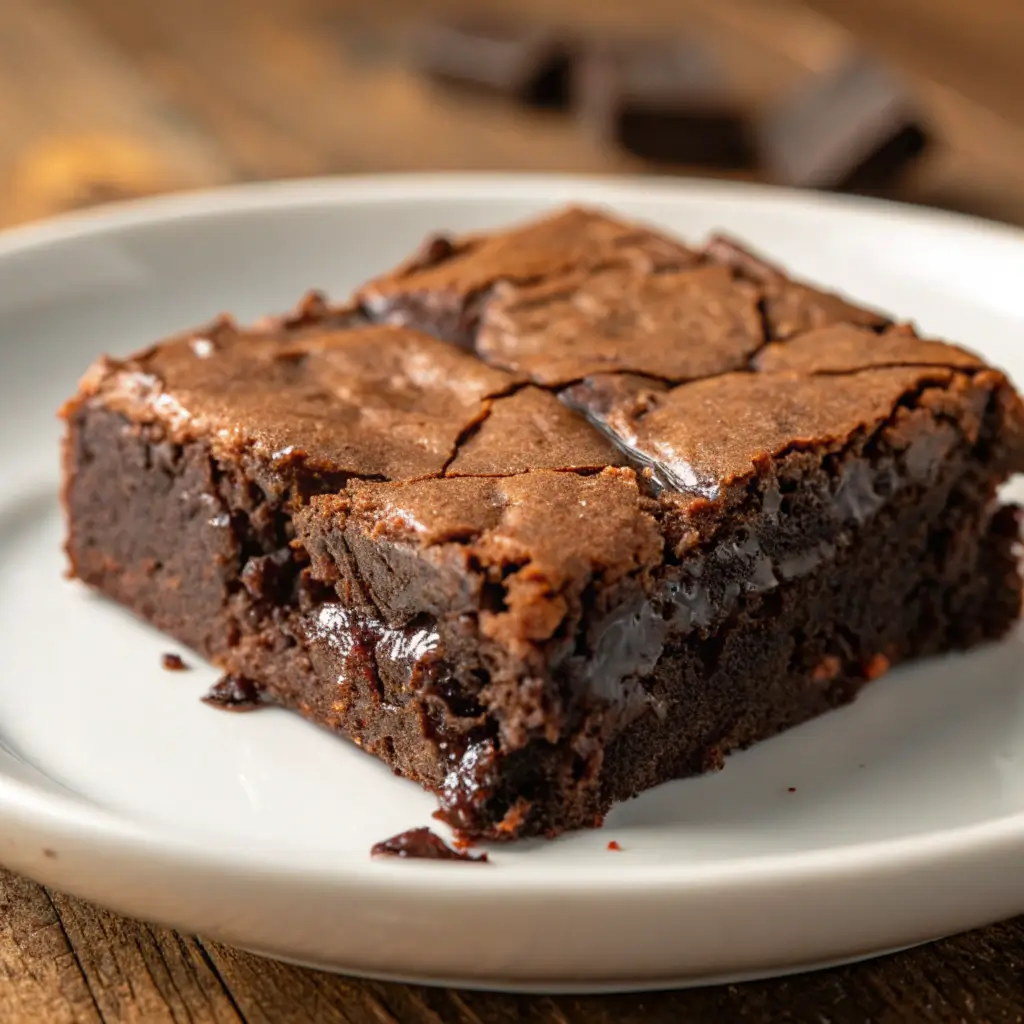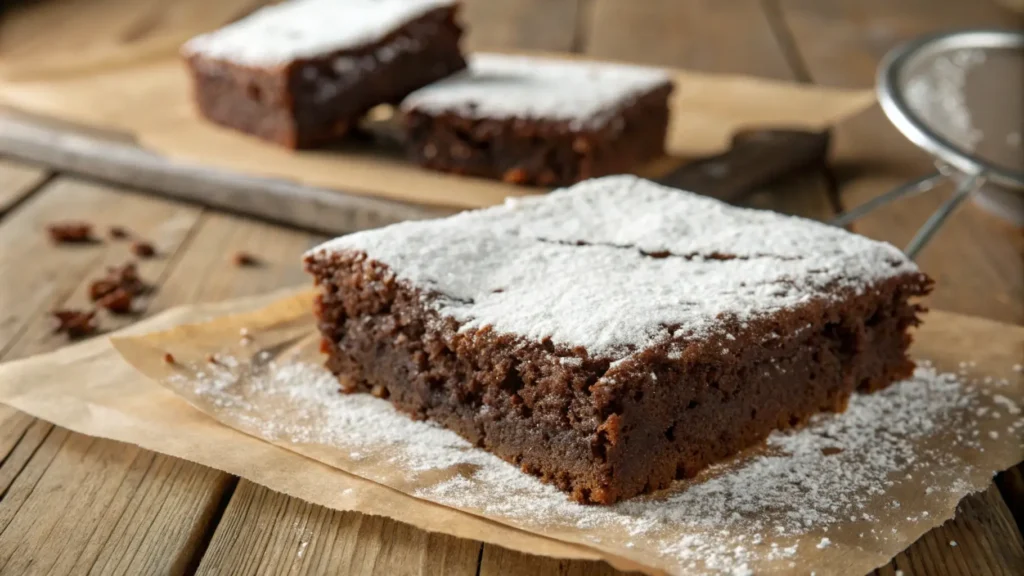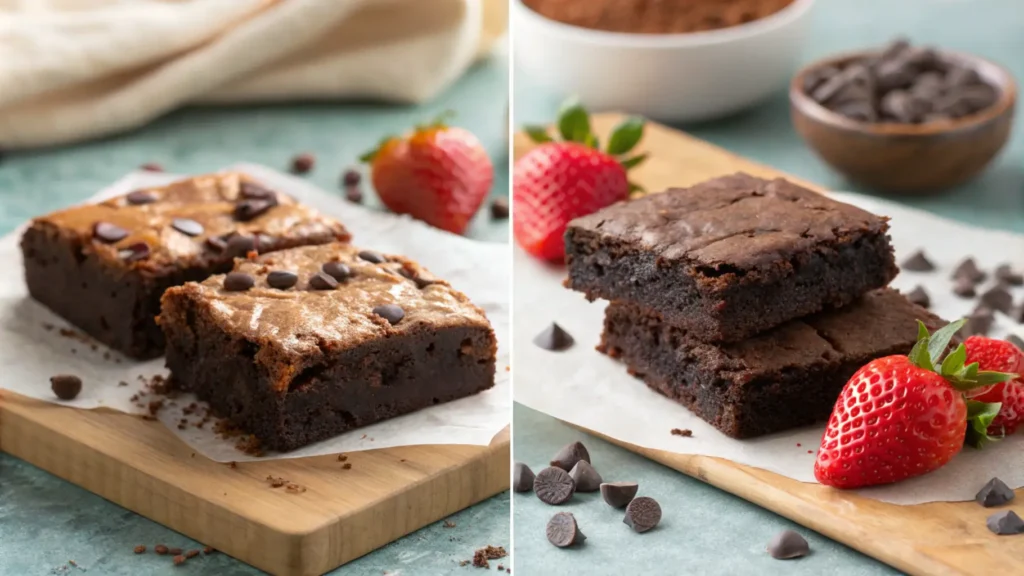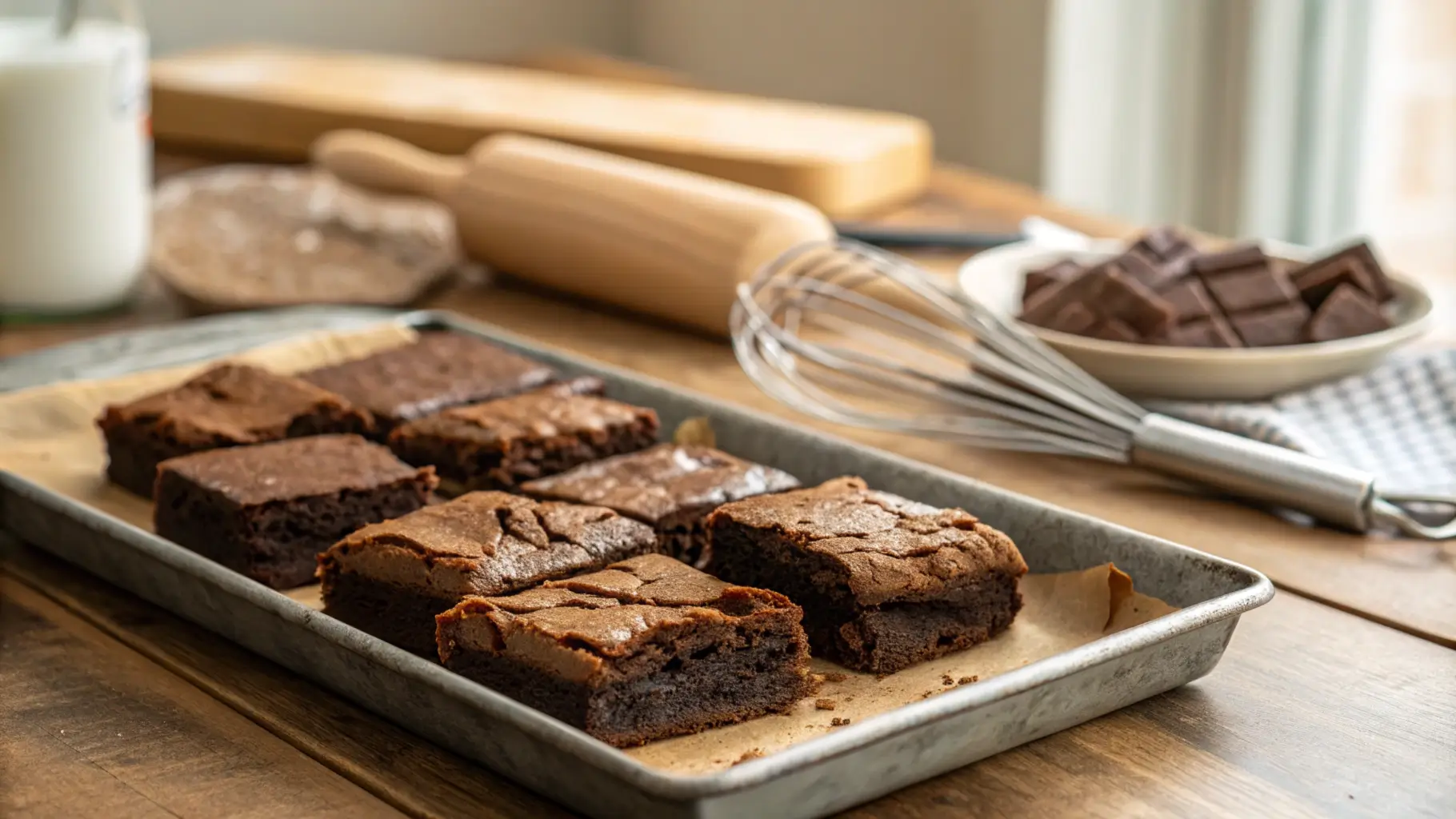Brownies are a favorite treat for many, but people often disagree on one key detail: texture. Do you love a soft, gooey fudgy brownie or a fluffy, light cakey brownie? The difference comes down to how the ingredients, methods, and baking process work together. In this article, we’ll explain what makes brownies fudgy or cakey and share tips to help you bake the perfect ones for your taste.
What Makes Brownies Fudgy vs. Cakey?
The difference between fudgy brownies and cakey brownies comes down to texture. Fudgy brownies are rich, moist, and dense, while cakey brownies are light, soft, and airy, similar to a sponge cake. These contrasts arise from changes in ingredient amounts and how the batter is prepared.
Fudgy Brownies:
A fudgy brownie is rich, thick, and full of chocolate flavor. Its soft, moist texture is like a truffle, with a slightly underbaked center that melts in your mouth. It’s the ultimate comfort food, offering pure satisfaction with every bite.
Cakey Brownies:
On the other hand, cakey brownies have a structure closer to a light sponge cake. They rise higher due to added leavening agents and more flour, creating a less dense but equally satisfying treat. If you enjoy a brownie that pairs well with a dollop of ice cream, the cakey variety might be your go-to.
Why Texture Matters in Brownies
Texture can transform a simple brownie into a sensory experience. It affects how the chocolate flavor hits your palate and interacts with other elements, like toppings or mix-ins. Understanding the mechanics of these differences is the first step to baking brownies exactly how you like them.
The Role of Ingredient Ratios in Determining Brownie Texture
The magic of baking lies in how each ingredient influences the final product. With brownies, the ratios of fats, sugars, and flour are critical in shaping their texture. Small tweaks can mean the difference between a fudgy, dense dessert and a light, cakey treat.
For a detailed breakdown of how ingredient ratios affect brownie textures, check out this guide from Recipe for Perfection.
Fat-to-Flour Ratio: Key to Fudginess
Fats, like butter and oil, bring moisture and richness to brownies. A higher fat-to-flour ratio creates a luscious, gooey texture that defines fudgy brownies. Butter, in particular, contributes flavor and silkiness, while oil can add even more moisture.
Leavening Agents: Creating a Cakey Structure
For cakey brownies, ingredients like baking powder or whipped egg whites are key. They create tiny air pockets in the batter, making it rise and giving the brownies a soft, light texture. But be careful—not enough leavening can make them dense, while too much can make them dry. Precision is the secret!
How Sugar Affects Texture
Sugar does more than just sweeten brownies—it helps shape their texture too. White sugar creates a crisp top and balanced chew, while brown sugar brings more moisture, making the brownies softer and fudgier. Its role in keeping brownies moist and chewy is often underestimated!
Moisture Retention and Baking Times
The time spent in the oven has just as much impact as the ingredient ratios. Overbaking can quickly dry out brownies, pushing even a fudgy batter toward cakey territory. Finding the perfect bake time ensures the interior retains enough moisture without becoming undercooked.
The Impact of Fats on What Makes Brownies Fudgy or Cakey

Fats play a crucial role in determining what makes brownies fudgy vs cakey. Butter provides a rich, creamy flavor and contributes to the glossy, crackly top often seen in fudgy brownies. Oil, with its superior moisture-retaining properties, makes brownies even denser and gooier.
- For Fudgy Brownies: Use more butter or oil to increase richness and moisture.
- For Cakey Brownies: Reduce the fat slightly to allow the batter to firm up during baking.
Sugar and Its Role in What Makes Brownies Fudgy or Cakey
Sugars, like white and brown, affect both the flavor and structure of brownies. White sugar tends to crystallize, creating a firmer texture and helping develop the crackly top. Brown sugar, with its molasses content, adds moisture and chewiness, a hallmark of fudgy brownies.
How Eggs Contribute to What Makes Brownies Fudgy or Cakey
Eggs act as a binder and leavening agent, making them a key ingredient in shaping what makes brownies fudgy vs cakey.
- For Fudgy Brownies: Use fewer eggs to minimize air incorporation.
- For Cakey Brownies: Add an extra egg or whip the eggs more thoroughly to increase airiness.
The Role of Chocolate: Cocoa Powder vs. Melted Chocolate
Chocolate choices are instrumental in determining texture. Melted chocolate contributes richness and moisture, ideal for fudgy brownies. Cocoa powder absorbs more liquid, lending itself to cakey brownies.
Flour’s Function in What Makes Brownies Fudgy vs Cakey
Flour provides structure but can also make brownies overly dense if used excessively.
For Cakey Brownies: Slightly increase flour to encourage a more defined crumb.
For Fudgy Brownies: Use less flour to keep the batter moist and dense.
Mixing Methods: Stirring vs. Whisking

How you mix your brownie batter can make a noticeable difference in the final texture. For fudgy brownies, stirring gently until the ingredients are just combined helps preserve the dense texture. Overmixing introduces air into the batter, which is better suited for cakey brownies.
- For Fudgy Results: Fold in ingredients with a spatula or spoon, avoiding excess air.
- For Cakey Results: Whisk vigorously to aerate the batter, creating a lighter texture.
Baking Times and Temperatures
Baking times and oven temperatures are pivotal for achieving the perfect texture. Fudgy brownies benefit from shorter baking times at slightly lower temperatures, ensuring the center remains moist. In contrast, cakey brownies require a longer bake at a consistent temperature to set the crumb and promote an even rise.
- Tip for Fudgy Texture: Remove brownies from the oven when the edges are set, but the center still has a slight jiggle.
- Tip for Cakey Texture: Bake until a toothpick inserted near the center comes out clean, signaling doneness.
Pan Types and Sizes
The pan you use also influences how your brownies bake. Metal pans conduct heat more effectively, giving crisp edges and evenly baked brownies. For a denser texture, use a smaller pan, which results in thicker slices that retain more moisture in the center.
- For Fudgy Brownies: Use an 8×8-inch metal pan for a thicker result.
- For Cakey Brownies: A 9×13-inch glass or metal pan allows for a thinner, evenly baked batch.
Using Parchment Paper or Greasing the Pan
Lining your pan with parchment paper can prevent sticking and make removal easier. This method is especially helpful for fudgy brownies that might otherwise fall apart when cut.
Adding Mix-ins: Nuts, Chocolate Chips, and More
Mix-ins can elevate your brownies from simple to spectacular. Whether you love the crunch of nuts or the indulgence of extra chocolate, adding these ingredients can enhance both flavor and texture.
- For Fudgy Brownies: Add chocolate chunks or chips for bursts of gooeyness that complement the moist texture.
- For Cakey Brownies: Stir in chopped nuts or dried fruits to add contrasting texture without overpowering the crumb.
Popular Add-Ins:
- Walnuts, pecans, or almonds for a crunchy contrast.
- Peanut butter swirls for a salty-sweet pairing.
- White chocolate chips or butterscotch for unique flavor notes.
Flavor Variations: Vanilla, Coffee, and Spices
You can easily adjust the flavor of brownies with simple tweaks to match your preferences. Adding a touch of espresso powder deepens the chocolate flavor, while vanilla extract offers a comforting note that complements both fudgy and cakey brownies.

- For Adventurous Bakers: Add a pinch of cinnamon or chili powder for a bold, spicy kick.
- For a Rich Chocolate Boost: Stir in brewed coffee or a bit of espresso powder for a more intense flavor.
Topping Ideas for the Perfect Brownie Finish
The toppings you choose can make all the difference in how your brownies are enjoyed.
- For Fudgy Brownies: A drizzle of rich ganache or a sprinkle of sea salt brings out their luxuriousness.
- For Cakey Brownies: A light dusting of powdered sugar or a thin glaze adds just the right amount of sweetness without overwhelming the delicate crumb.
Adjusting Brownie Recipes for Special Diets
Making brownies that fit specific dietary needs is simple without compromising on texture or flavor.
- Replace all-purpose flour with almond or coconut flour for a gluten-free version.
- Swap eggs for flaxseed meal or unsweetened applesauce to create a vegan-friendly recipe.
These tweaks ensure everyone can enjoy brownies, regardless of their dietary preferences.
Frequently Asked Questions
Can I add peanut butter to my brownie mix?
Yes, peanut butter is a fantastic addition to brownie mixes, whether store-bought or homemade. You can swirl it into the batter before baking for a marbled effect or layer it between two portions of batter for a gooey center. Just ensure it’s evenly distributed to avoid pockets of dryness.
For detailed steps on how to add peanut butter to your mix, check out this guide.
Can I substitute peanut butter for oil in brownies?
Absolutely, but with caution. Peanut butter can replace oil in a 1:1 ratio, though it may slightly alter the texture. The brownies will be denser and less oily, with a hint of nutty flavor. Opt for creamy peanut butter for smoother results, and avoid varieties with added sugar to maintain the sweetness balance.
Learn more about substituting peanut butter for oil in this complete guide.
Is it better to use milk or water in brownies?
Milk is better for creating richer, creamier brownies compared to water. The added fat and protein in milk contribute to a more tender crumb, making it an excellent choice for cakey brownies. However, water works just fine for fudgy brownies, as it doesn’t interfere with the dense texture.
For a more detailed comparison, check out this Milk vs Water in Brownies guide.
How to add peanut butter to a brownie recipe?
To add peanut butter to your brownies, gently warm it so it spreads easily. Use a knife to swirl it into the batter for a pretty and flavorful touch, or mix it straight into the batter for an even taste throughout. Want extra texture? Toss in some chocolate chips with the peanut butter before swirling!
How to add peanut butter to a cocoa brownie recipe?
For cocoa brownies, peanut butter adds depth and creaminess. After preparing the cocoa-based batter, spoon dollops of peanut butter over the top and use a knife to create swirls. For an extra indulgent treat, mix cocoa powder into the peanut butter before swirling for a double-chocolate twist.
Mastering What Makes Brownies Fudgy vs Cakey
What Makes Brownies Fudgy vs Cakey? Key Takeaways
Creating brownies that suit your preferences—whether fudgy brownies or cakey brownies—relies on balancing ingredients and using the right techniques. Understanding this balance allows you to adjust recipes to achieve your perfect dessert texture.
How Ingredient Ratios Affect Fudgy vs Cakey Brownies
The proportions of fats, sugars, eggs, and flour are pivotal in determining whether brownies come out fudgy or cakey. Higher fat content makes brownies moist and dense, while more flour and eggs produce a fluffy crumb.
Key Techniques to Perfect Fudgy or Cakey Brownies
Mastering what makes brownies fudgy vs cakey involves careful attention to mixing, baking times, and pan selection. For a fudgy brownie, stir ingredients gently and underbake slightly. To make cakey brownies, whisk vigorously and bake thoroughly for a firm structure.
Flavor Boosts for Fudgy and Cakey Brownies
Enhancing your brownies with mix-ins like nuts, chocolate chips, or peanut butter can complement both textures. For fudgy brownies, try swirls of peanut butter or ganache. For cakey brownies, a topping of powdered sugar or a light glaze works wonderfully.
Choosing Between Fudgy or Cakey Brownies for Your Recipe
Your personal taste dictates what makes brownies fudgy vs cakey for you. Experimenting with different ratios and baking methods lets you discover your ideal version of this beloved treat.
By incorporating these tips and techniques, you’ll always know how to bake brownies that meet your cravings. With this knowledge, every batch will be a success.

